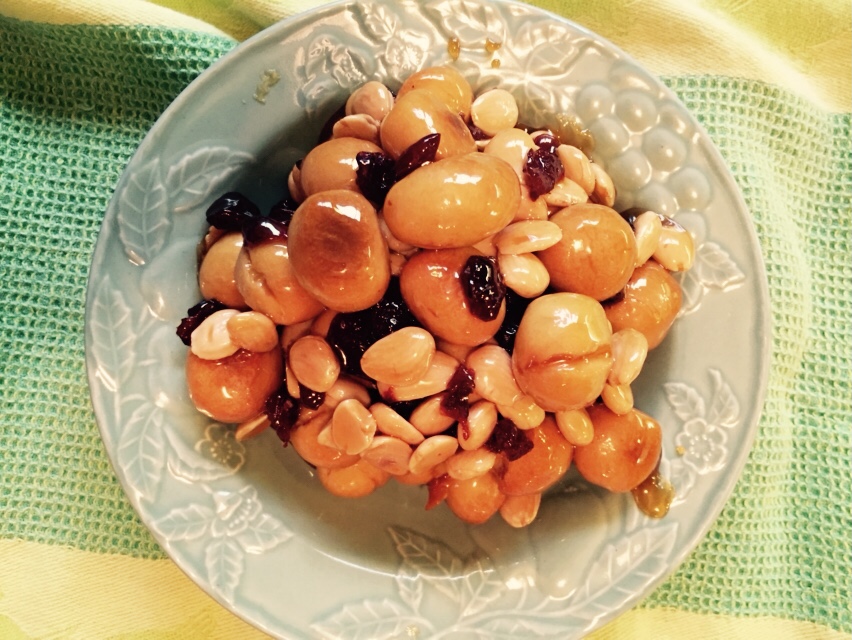One of the most well-known customs of Rosh Hashanah is the dipping of apple pieces in honey. But what is its origin?
Samuel II chronicles the distribution, in the time of King David, of a “cake made in a pan and a sweet cake,” which given to everyone. The Book of Hosea identifies the “sweet cake” as a raisin cake.
The Torah also describes Israel as the land flowing with milk and honey, although the honey was more than likely date honey, a custom retained by many Sephardic Jews to this day. The honey of ancient Eretz Yisra’el was made from dates, grapes, figs or raisins because there were no domestic bees in the land. At that time, only Syrian bees were there, and to extract honey from their combs, it had to be smoked. Still, honey was of importance in biblical times, as there was no sugar readily available.
During the Roman period, Italian bees were introduced to the Middle East, and bee honey was more common.
Today, Israel has roughly 500 beekeepers who tend to some 90,000 beehives, producing more than 3,500 tons of honey annually. Kibbutz Yad Mordechai, about 10 kilometres south of Ashkelon, is the country’s largest honey producer, responsible for 10,000 bottles a day.
At this time of year, Ashkenazic Jews have a custom of replacing the salt that is usually sprinkled on challah for the ha-Motzi blessing with honey. A prayer – “May it be Your will to renew for us a good and sweet year” – and bracha are then said over the apple, which is dipped in honey.
So honey is used to symbolize the desire for a sweet new year. But what about the apple?
In Genesis, Isaac compares the fragrance of his son, Jacob, to that of a field, which Rashi explains as a field of apple trees. As well, scholars tell us that mystical powers were ascribed to the apple, and people believed it provided good health and personal well-being.
Some attribute the use of an apple to the translation of the story of Adam and Eve and the forbidden fruit that led to their expulsion from the Garden of Eden.
According to Gil Marks’ Encyclopedia of Jewish Food, “the first recorded association of apples with Rosh Hashanah was in Machzor Vitry, a siddur compiled around 1100, which included this explanation:
‘The residents of France have the custom to eat on Rosh Hashanah red apples.’ Future generations of Ashkenazim adopted the French custom … leading to the most popular and widespread Ashkenazic Rosh Hashanah tradition.”
Rabbi Jacob ben Asher, who was born around 1269 and fled with his family to Spain in 1303, was the first to mention the custom of apples dipped in honey in his legal compendium, Arbah Turim (written circa 1310), citing it as a German tradition.
A few years ago, an article revealed that the average Israeli eats 125 apples and 750 grams of honey a year, mostly around the High Holidays. Israel is very self-sufficient with regard to apples, with around 9,900 acres cultivated yearly.
READ: POMEGRANATES ARE A MIRACLE FRUIT
The Hebrew word for “honey,” dvash, has the same numerical value as the phrase Av ha-Rachamim (Father of Mercy). We hope that God will be merciful as He judges us for our year’s deeds on Rosh Hashanah.
Meanwhile, Moroccans dip apples in honey and serve cooked quince, which is an apple-like fruit, symbolizing a sweet future. Some Moroccans also dip dates in sesame and anise seeds and powdered sugar.
Among some Jews from Egypt, a sweet jelly made of gourds or coconut is used to ensure a sweet year, and apples are dipped in sugar water instead of honey.
Honey is also used by Jews around the world in desserts at this time of year.
Some maintain that the last part of the phrase “Go your way, eat the fat and drink the sweet,” found in Nehemiah, refers to apples and honey.
Here are some recipes using honey for your Rosh Hashanah eating.
Tishpishti (Middle Eastern Honey-Nut Cake)
Honey syrup
1 1/2 cups honey
2/3 cup water
1/3 cup sugar
1/4 cup lemon juice
Cake
o 2 cups finely ground almonds, hazelnuts, pistachios or walnuts
o 1 cup cake meal
o 2 tsp orange juice
o 1 tsp ground cinnamon
o 1/2 tsp allspice or ground cloves
o 6 eggs
o 1 cup sugar
o 1/2 cup vegetable oil
o 1 tbsp grated orange or lemon zest
Stir honey, water, sugar and lemon juice in a saucepan over low heat until the sugar dissolves (about five minutes). Increase heat to medium, bring to a boil and boil for one minute. Let cool.
Preheat oven to 175 C (350 F). Grease a 33 cm x 23 cm (13 inch x 9 inch) baking pan.
Combine nuts, cake meal, cinnamon and cloves in a mixing bowl.
In another bowl, beat egg yolks with sugar. Add to nut mixture with orange juice. Add oil and orange or lemon zest.
In a third bowl, beat egg whites until stiff but not dry. Fold into batter. Pour batter into baking pan and bake in preheated 175 C (350 F) oven for 45 minutes. Let cool.
Cut cake into one- to two-inch squares or diamonds. Drizzle cooled syrup over the warm cake. Serve warm or at room temperature.

My Grandma Sade’s Teiglach
My grandmother was born in New Jersey, although her mother came to the United States as a young girl from Russia, so she probably learned this eastern European dish from her mother. Teiglach means “little dough pieces,” and was originally for family celebrations and various holidays. Today, it is made primarily for Rosh Hashanah as a symbol for the sweet new year.
My favourite reference book for any food is the Encyclopedia of Jewish Food by Gil Marks, who wrote teiglach were brought to the United States by eastern Europeans in the early 1900s, although nuts were not part of the recipe in the “old country.”
o 2 1/2 cups flour
o 1 tsp baking powder
o 4 tbsp oil
o 4 eggs
o 1/8 tsp salt
o 3/4 cup brown sugar
o 1 1/3 cups honey
o 1 tsp ground ginger
o 1/2 tsp ground nutmeg
o 1 cup finely chopped pecans
In a mixing bowl, combine flour, baking powder, oil, eggs and salt. Stir until a dough is formed.
In a saucepan, boil sugar, honey, ginger and nutmeg for 15 minutes.
Wet a board with cold water.
Pinch pieces of dough and drop them into the boiling honey mixture. Cook until very thick. Add nuts and stir. Pour honeyed pieces onto the wet board and cool slightly.
With wet hands, shape dough into two-inch balls or squares. Let cool. Store in an airtight container.
Two-Layer Apple and Honey Cake
This was in my recipes files, but I have made changes and I do not know the original source.
o 2 cups flour
o 3/4 cup sugar
o 2 tsp baking soda
o 1 tsp salt
2 tsp ground cinnamon
o 1/4 tsp ground cloves
o 1/8 tsp ground nutmeg
o 3/4 cup vegetable oil
o 2 large eggs
o 1/3 cup pareve milk
o 1/2 up honey
o 1 1/2 tsp vanilla extract
o 3 cups coarsely grated apples
Tofu cream cheese frosting
16 ounces tofu cream cheese
1/2 cup unsalted pareve margarine
1 cup confectioners’ sugar
2 tsp vanilla extract
1 tsp grated orange peel
1/2 cup honey
Cake
Preheat oven to 160 C (325 F). Prepare two 23-cm (9-inch) cake pans.
In a large bowl, whisk flour, sugar, baking soda, salt and spices. Form well in the centre.
Add oil, eggs, milk, honey and vanilla. Whisk until moistened.
Fold in apples. Spoon half of mixture into each baking pan. Bake in preheated 160 C (325 F) oven for about 45 minutes or until a tester inserted into the centre comes out clean. Let cakes cool.
Frosting
Beat cream cheese and margarine in a bowl until fluffy. Add sugar, vanilla and orange peel. Add honey and beat until smooth.
Chill the frosting.
Place one cake flat-side up on a serving dish. Spread with one cup frosting.
Top with second layer, flat-side down. Spread remaining frosting on top and sides of cake.






